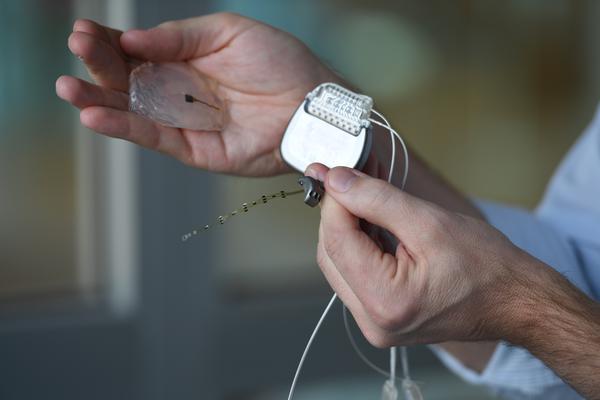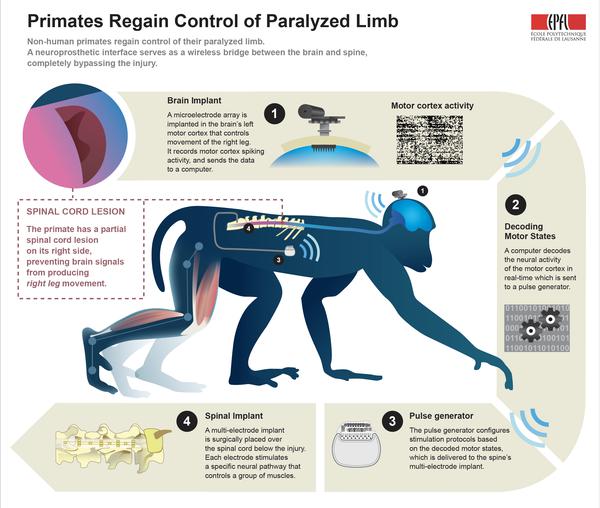The interface decodes brain activity associated with walking movements and relays this information to the spinal cord - below the injury — through electrodes that stimulate the neural pathways that activate leg muscles during natural locomotion.
The neuroprosthetic interface was conceived at EPFL in Lausanne, Switzerland, and developed together with an international network of collaborators including Medtronic, Brown University and Fraunhofer
«This is the first time that neurotechnology restores locomotion in primates," says neuroscientist Grégoire Courtine who led the collaboration and holds the IRP chair in spinal cord repair. «But there are many challenges ahead and it may take several years before all the components of this intervention can be tested in people.»

Decoding brain signals and activating leg muscles
The brain is a huge network of cells called neurons. Information is processed in the brain by transmitting spikes of electricity from one neuron to the next. This electrical spiking gives rise to brain signals that can actually be measured and interpreted.
The lumbar region of the spinal cord also contains complex networks of neurons that activate leg muscles to walk. Bundles of nerves coming from the brain carry the relevant information to the spinal cord about the intended activation of leg muscles.
For intact nervous systems, signals about walking come from a small region (about the size of a dime for primates) of the brain called the motor cortex. Signals from the motor cortex travel down the spinal cord, reach the neural networks located in the lumbar region, and these in turn activate muscles in the legs to produce walking movements.
Spinal cord lesions partly or completely prevent these signals from reaching the neurons that activate leg muscles, leading to paralysis. But the motor cortex can still produce spiking activity about walking, and the neural networks activating muscles in the paralyzed leg are still intact and can still generate leg movements.

How the brain-spine interface works
The
«To implement the
For partial lesions of the spinal cord, the scientists showed that the primate regained control of its paralyzed leg immediately upon activation of the
«The primate was able to walk immediately once the
Clinical Trials
«The link between the decoding of the brain and the stimulation of the spinal cord — to make this communication exist — is completely new," says neurosurgeon Jocelyne Bloch of the Lausanne University Hospital (CHUV) who leads the functional neurosurgery department at the Lausanne University Hospital and surgically implanted the brain and spinal cord implants.
She continues, «For the first time, I can imagine a completely paralyzed patient able to move their legs through this
In collaboration with EPFL, Bloch is currently leading a clinical feasibility study that evaluates the therapeutic potential of this spinal cord stimulation technology, without the brain implant, to improve walking in people with partial spinal cord injury affecting the lower limbs.
Source: https://actu.epfl.ch/news/primates-regain-control-of-paralyzed-limb/


